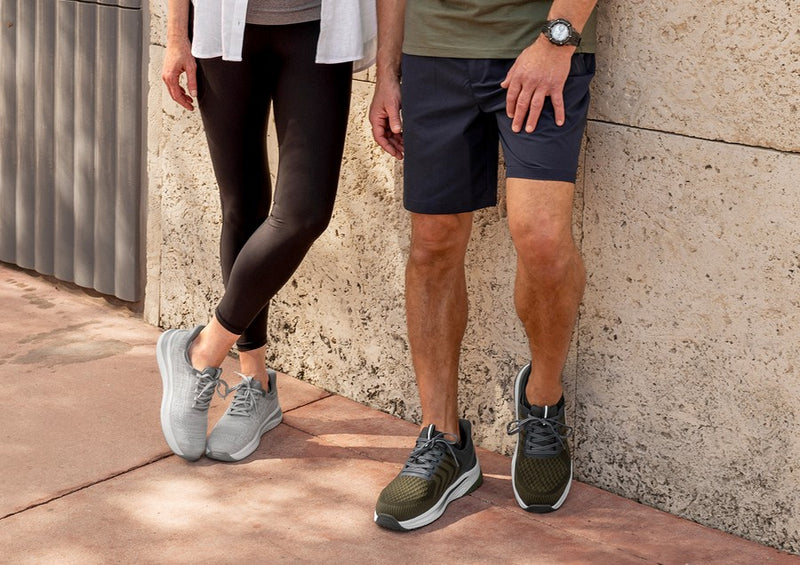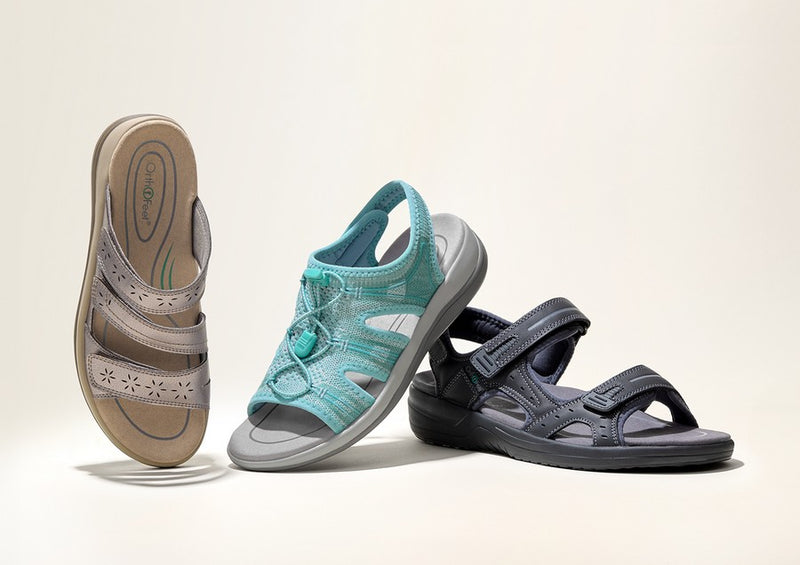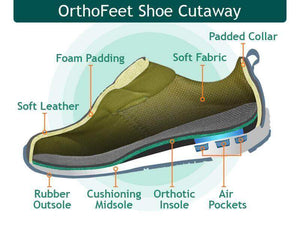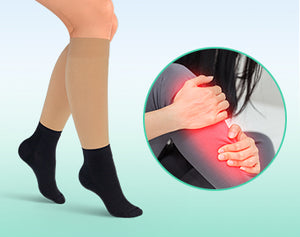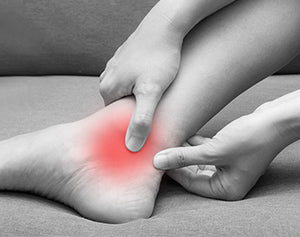The Orthofeet Blog
- All Posts
- All
- Arch Support
- Back Pain
- Bunions
- Diabetes
- Flat Feet
- Foot Pain
- Hammer Toes
- Heel Pain
- Heel Pain/ Heel Spurs
- Knee & Hip Pain
- Knee pain
- Morton Neuroma
- Orthopedic shoes
- Other
- Overpronation
- Plantar Fasciitis
Plantar Fasciitis
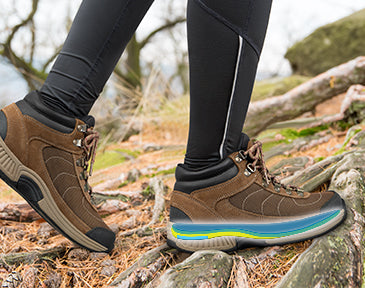

Josh White DPM / August 12, 2021
The Best Hiking Boots for Plantar Fasciitis
The Best Hiking Boots for Plantar Fasciitis Read Post
-
Can Plantar Fasciitis Cause Leg Pain?
By Steven Gershman DPM / September 05, 2023Plantar fasciitis is causing "a real pain in the foot”. That is what many patients complain about to me as it disrupts their life. It makes it hard to stand, walk, run, and work. Many patients have severe issues working with this foot condition, as plantar fasciitis pain can be very debilitating. Essentially, what can seem like just foot pain can be life-altering. Leg pain and plantar fasciitis So, can plantar fasciitis cause leg pain? The answer is a definite YES. In addition to foot pain, there can be pain radiating up the leg. This can occur directly from nerve pain at the calcaneus branches, which can radiate back up the nerve tract in the leg, causing ankle and calf pain. Another cause of leg pain is when there is pain on the foot and in particular at the heel, people often change their stance and gait to avoid the painful area. This alters normal lower extremity mechanics, which can lead to overuse injuries or pain to the muscles and tendons in the lower leg, and sometimes in the upper leg, hip and back. So, treatment for plantar fasciitis can affect more than just the foot. What is plantar fasciitis? Well, the story starts with discussing the culprit: the plantar fascia is a thick, web-like ligament on the bottom of the foot. The plantar fascia lies just under the skin and in most people it can be easily seen and felt by pulling the toes up. This causes the fascia to tighten and stick out to be easily visualized and palpated, especially in the arch area. It feels like a tight band there. Anatomically, the plantar fascia connects from the calcaneus (the heel bone) to the base of the toes, which means it stretches almost the full length of the foot. Like a ligament, it connects bone to bone, but structurally it is closer to a tendon with limited blood and nerve supply. These characteristics are part of the reason it is often slow to heal from injury. The plantar fascia is made of collagen-based connective tissue and as it stretches out in a wide band, it is properly called an Aponeurosis. Functionally, the fascia acts like a tie-rod to hold the foot together as it connects the toes to the heel. When the arch is at maximal height, the fascia is shorter as the foot is shorter. As a person stands and the arch drops, the foot lengthens and stretches, elongating and tightening the fascia. In the gait cycle when walking or running, as a person pushes off, the toes flex back, which causes the fascia to tighten and raises the arch to stabilize the foot for propulsion. This is called the windlass mechanism. Dysfunction in this action is one of the causes of plantar fasciitis, as will be discussed later in this blog. Symptoms of plantar fasciitis Plantar fasciitis is pain anywhere on the fascia, including the most common bottom of the heel pain. The most prevalent scenario is pain when first standing and then it often temporarily improves after moving around, only to get worse as there is continued activity. Often, the more time on the feet, the worse the pain. It is not truly an inflammation as much as actual micro trauma damage to the fascia with some structural breakdown, due to being overworked or stressed. There can also be periostitis of the heel bone - inflammation of the periosteum, the coating over the bone. As the fascia connects to the periosteum, it becomes all involved and is called plantar fasciitis. In all my years of treating heel pain, this is more common than pain further up the fascia in the arch. Another type of pain in the bottom of the foot can involve neuritis or nerve pain, as the heel has several nerve branches passing along and under it. If these nerves are irritated, there can be a burning pain radiating around the heel and often pain up the leg. Often, neuritis occurs together with fasciitis, causing foot and leg pain. As we age, the fat pad on the bottom of the heel thins out, which can lead to periostitis from direct trauma to the bone or periosteum, and/or neuritis from the nerve under the heel being compressed between the bone and the floor. What causes plantar fasciitis? There are multiple causes of this syndrome. Often, in a patient there is more than one cause. Dysfunction in the windlass mechanism mentioned above is a major cause. The fascia is overworked and stretched when the mechanism malfunctions, which leads to micro tears, structural damage and pain. A major cause of the windlass mechanism malfunctioning is dysfunction of the big toe joint to the foot. If the big toe can’t flex properly, the windlass mechanism will not work correctly and this can damage the fascia. Big toe joint dysfunction can occur from actual damage to the joint from arthritis or from over pronation, where the arch flattens on stance, jamming the joint. Other causes of plantar fasciitis are weight gain, which puts physical stress on the foot. The fascia being a tie-rod stabilizing the foot will be overworked by excess weight, as it works harder to handle the increased physical force. As mentioned above, fat pad atrophy with age can also cause pain in the heel at the fascia insertion on the heel. Simple over pronation, where the arch drops, causes lengthening of the foot, which puts a stretch force on the fascia as it attempts to hold the foot together. This over works the fascia, causing micro trauma and pain. This issue can be exacerbated by poor shoes or soft worn out shoes, as pronation is often worse with soft or poor shoes. Heel spur syndrome is not plantar fasciitis! At this point, I also want to discuss heel spur syndrome, as it is often confused with plantar fasciitis, especially when the pain is on the bottom of the heel. As the fascia connects to the bottom of the heel there can be fascia pain directly at the insertion point on the heel. This can also cause heel bone periostitis, as the fascia connects to the periosteum. There is often a heel spur that develops on the tubercle on the bottom of the heel bone, where the fascia inserts. The spur usually has little to do with the pain. In fact, on x-ray, the foot with no pain had a bigger spur than the painful foot. I tell my patients the spur is often more of a barometer measuring stresses on the foot, but not actually the cause of the symptoms. This means we don’t treat the spur itself and don’t need to remove it to minimize pain. How to treat plantar fasciitis With almost no exceptions I ALWAYS start with SHOES for plantar fasciitis treatment. We ask patients to bring in most of their shoes for their initial visit, and anytime thereafter they have pain. As noted above, shoes can be a major cause of fasciitis and other foot pain. If the shoes are worn out or improper, I start treatment by having them purchase new and more appropriate shoes.The shoes need to fit correctly, as I often find patients wear shoes too short or too tight. This can affect the big toe joint function, which damages the fascia, as can over pronation from poor shoes. I have seen many patients improve in 2 to 3 weeks from just purchasing new, more appropriate shoes that fit well. Each patient is different, so I can’t recommend a blanket one style of shoe, but in general, A solid heel counter to control motion. Have a solid outer sole. Have some motion control features. Click Here to Find Plantar Fasciitis Shoes. Many patients need extra depth and width for unrestricted toe movement and a pressure free environment. Good orthopedic footwear brands biomedically design plantar fasciitis shoes that help alleviate strain on the plantar fascia. Featuring ergonomic soles, such shoes reduce impacts on the heel and provide soft, protective cushioning. Click here to find plantar fasciitis shoes The next step in the treatment usually involves some type of plantar fasciitis insole or orthotic. Since many patient’s main symptom is heel pain, the insert should cup and cushion the heel and support the arch. In general, a well-made insole will reduce pronation and help improve big toe joint function, while cushioning the heel. This is the starting point in my office for most of these patients. In my practice, I use non custom orthotics as my first line of treatment along with shoes. The insoles I use have a gel heel pad in the heel cup, an anatomical arch support and tends to mold to the specific shape of the foot over time. They are very comfortable from the moment they are inserted in the shoes, which patients really appreciate and will actually wear them as a result. Click Here to Find Plantar Fasciitis Orthotics If this treatment doesn't work well enough, I will consider custom foot orthotics if they are appropriate for the patient. Cortico-steroid (cortisone) injections are another treatment. It may require 2 to 3 injections. I usually wait until the patient has proper shoes and inserts before I administer this, as the injection success rate is higher when administered in conjunction with the shoes and inserts. Also, another option for plantar fasciitis pain relief is oral steroids, such as prednisone or non-steroids such as ibuprofen. If all the above fails, I will have the patient wear an immobilizing boot 24 hours a day for a few weeks. To further increase effectiveness, the insole is inserted in the boot. From my findings, simple night splints are not very beneficial, but the walking boot worn also at night does have a powerful impact. Finally, if all the above treatment options don’t work, shock wave treatment may prove beneficial, or surgery as a last resort. The issue with surgery is that it may improve symptoms initially, but it does destabilize the foot in the long run, often leading to new pain later. For the most part, plantar fasciitis will resolve regardless in a year or less. Treatment helps speed it up. In summary, plantar fasciitis is very common. If you develop pain on the bottom of the foot, the sooner you seek out medical help, such as a podiatrist, the sooner you will improve. Waiting longer just causes more pain and is more complicated to treat, as well as slower.Read More -
Best Sandals for Plantar Fasciitis
Medical information provided by Steven Gershman DPM / May 03, 2023Summer is the time for fun and sun, when we can remove excess layers and go light with our wardrobe, including what we wear on our feet. However, this can come at a cost since many sandals are sometimes too simple and lack good design, materials and features which can damage our feet. This is especially true when you throw into the mix a foot condition such as plantar fasciitis. If you suffer from plantar fasciitis, you know that plantar fasciitis can cause leg pain as well as foot pain. To avoid that, your feet require supportive or orthotic sandals to keep symptoms at check. Ordinary sandals are typically flat, thin and do not have much or any cushioning, which can leave your feet in pain and you not being able to enjoy the activities you love most. They will also undoubtedly exacerbate your plantar fasciitis. But don’t fret, we are here to help you find the best summer sandals for plantar fasciitis. Best sandals for plantar fasciitis All our favorite plantar fasciitis sandals come with features that ease plantar fasciitis pain and minimize discomfort, and can even promote healing. These features are arch support, heel cushioning, ball-of-foot cushioning, wide shaped forefoot and an ergonomic sole. If you want to learn how and why these design features help with plantar fasciitis, continue reading. Now it’s time for the main course: our list of the best plantar fasciitis sandals. Best dress sandals for plantar fasciitis Women’s Paloma Why you’ll love it Fashionably diverse Multiple straps allow you to customize fit Specs Sizes: 5-12 Widths: Standard (B) - Wide (D) Upper materials: soft leather The fact that you can pair these stylish sandals with any outfit and look great is a given, but they have a lot more to offer than just a beautiful design. You have the ability to completely personalize the fit of the Paloma sandals by effortlessly modifying the multiple straps that run across the instep and toe area. This can enhance stability and give your feet the support they need. What’s more, the strap across the instep opens both sides, so you can choose which on-off wear is more comfortable for you: opening and closing the strap on the inside or outside of the sandal. If you have mobility issues, this is especially helpful. Available colors: camel and black. Shop Paloma Men’s Gemini Why you’ll love it 2 adjustable straps + a two-way strap system Fully padded to avoid irritation Specs Sizes: 7-14 Widths: Standard (D) - Extra Wide (4E) Upper materials: soft leather Let’s talk adjustable straps. With the Gemini sandals you get to enjoy both a stylish look and the ultimate comfort and convenience. Featuring three adjustable straps, you can easily adjust the sandal to fit your feet just right, without any discomfort or irritation. Plus, the innovative two-way strap system allows you to quickly and effortlessly fasten and unfasten your sandals from both sides, making it easier than ever to put them on and take them off. If, for any physical reason, you find it difficult to reach the external part of the sandal, this feature can be particularly beneficial. Seeing as the interior has some stretch, you can expect the sandal to fit like a…sock. Available colors: brown and black. Shop Gemini Best hiking sandals for plantar fasciitis Men’s Clearwater Why you’ll love it Multiple adjustability options Closed toe design protects the feet at all times Specs Sizes: 7-14 Widths: Standard (D) - XX Wide (6E) Upper materials: leather The Clearwater sandals feature uppers made from a soft leather and breathable fabric combination that provides ventilation and a comfortable fit throughout the day. These sandals offer three customizable fit options. The bungee cord allows you to adjust the width; the two-way strap across the instep allows you to secure the fit and to fasten and unfasten the sandal on either side; and the heel strap ensures a snug fit at the back of the foot. The fisherman closed toe design offers maximum protection for sensitive feet and is also ideal for activities in rougher terrain. Available colors: brown. Shop Clearwater Women’s Laguna Why you’ll love it Orthotic insoles with anatomical arch support Exceptionally breathable and lightweight Specs Sizes: 5-12 Widths: Standard (B) - Extra Wide (2E) Upper materials: stretch knit The Laguna sandals' adjustable fit provides multiple options through a bungee cord across the instep and a heel strap, ensuring a secure and customized fit for optimal comfort. Beyond fit adjustments, the wide toe box of the sandals caters to various forefoot conditions, alleviating pressure on sensitive areas and allowing for natural toe movement. The breathable and lightweight knit fabric ensures a cool and comfortable experience, while the orthotic insole offers anatomical arch support that enhances foot alignment. The sole design evenly transfers forces from the heel to the toe, easing the walking experience. The seamfree interior, gentle against bare skin, guarantees maximum comfort, crucial for individuals with heightened sensitivity. Available colors: blue, peach, gray Shop Laguna Best flip flops for plantar fasciitis Women’s Clio Why you’ll love it Chic meets practicality Adjustable strap on both sides Specs Sizes: 5-12 Widths: Standard (B) - Wide (D) Upper materials: synthetic If you’ve been avoiding wearing flip flops because they are flat and really bad for your feet, especially if you have plantar fasciitis, now you can finally wear them without pain as the Clio flip flops come with a full blown arch support. These toe-post sandals come with the added advantage of having adjustable straps on both sides of the foot, which can be customized to provide a secure fit. The toe post is both thin and soft, to avoid any discomfort. This means you won’t need to break them in gradually to avoid irritation between your toes. Happy times! In addition, the rubber outsole ensures you are stable on feet and allows for unrestricted walking. Available colors: brown and black. Shop Clio Men’s Eldorado Why you’ll love it Super stylish yet extremely comfortable A thin toe post made with soft material Specs Sizes: 7-14 Widths: Standard (D) - Extra Wide (4E) Upper materials: stretch knit Unlike your typical flip flops, the Eldorados offer unique features, first and foremost arch support that doesn’t put stress on your fascia, leading to pain. The velcro strap on the instep ensures a secure fit and improved stability, while the intentionally thin and soft toe post prevents any discomfort or irritation between the toes. In addition, the soft leather upper is padded with fabric, so that your feet won’t experience any irritation even on the hottest of days. Available colors: black. Shop Eldorado What special features do plantar fasciitis sandals need to have? The plantar fascia is a band of tissue that connects the toes and heel, and helping it function is key to maintaining a healthy foot and treating plantar fasciitis. Repetitive stress, excess body weight and shoes without support can increase tension on the fascia, causing it to overstretch, tear and become inflamed. Sandals for plantar fasciitis are designed to support the arch, absorb shock forces, and distribute pressure evenly to minimize pain and discomfort. The best sandals for plantar fasciitis should be designed with: Arch support: Sandals designed with built in arch support, or orthotic insoles, support the plantar fascia so it doesn’t over pull on the heel bone insertion. The insole reduces the arch drop that lengthens the foot which stretches the fascia. Orthotics also unlock a dysfunctional big toe joint by reducing the pronation that can cause it. Heel cushioning: Heel pain and plantar fasciitis are closely related and oftentimes misdiagnosed. However, today we know that plantar fasciitis causes the onset of heel pain. In addition, as we age and the more active we are, our natural fat pad located under the heel begins to wear out and thin. Plantar fasciitis sandals should have robust cushioning in the heel, such as gel or foam, to protect the area and alleviate the pain. Ball-of-foot cushioning: Since the plantar fascia connects the heel to the toes, it can become damaged and inflamed at any part, including the ball-of-foot area. The best plantar fasciitis sandals will have thick padding in the toe area to offset pressure from the metatarsal heads. Wide shaped forefoot: Sandals, especially if they are closed toe, need to have a wide and round shape in the front to give the toes plenty of space to move around. The space will prevent overlapping toes, promote biomechanical foot motion, and not put any extra pressure on the big toe joint. If the sandals are open toe, you need to make sure they are wide enough and the shape accommodates the toes so they are not bulging out from the sides. Ergonomic sole: Sandals for plantar fasciitis should be designed with a heel height that is close to the height of the front part of the shoe, so that the heel and forefoot are on the same level. Sandals with significantly elevated heels pose a problem as they place excess pressure on the big toe joint which is one cause of plantar fasciitis.Read More -
The Best Hiking Boots for Plantar Fasciitis
Medical information provided by Josh White DPM / January 11, 2023I fell in love with hiking during the pandemic, since it was pretty much the only activity I could do during lockdown and social distancing. Now, I‘m not talking about climbing Mount Everest, but just being outdoors surrounded by untouched nature was enough to unwind me and provide my body with the exercise it needs to maintain a healthy lifestyle. However, I also suffer from plantar fasciitis, which definitely isn’t compatible with any strenuous activity on the foot. One of the main causes of plantar fasciitis is participation in physical activities that put a lot of stress on the heel and attached tissue, or a sudden and rapid increase in levels of physical activity. In other words, hiking can exacerbate the condition if I didn’t take any specific action to prevent and comfort it. Treating plantar fasciitis is not difficult and most of the time the condition will improve over time with the right shoes, orthotics and care. Luckily, I was able to continue hiking despite my plantar fasciitis, thanks to boots made by shoe brands that really know what they are doing and specialize in problem feet. I was fortunate enough to test some styles out so that I can share my experiences with you. The best waterproof boots for plantar fasciitis Hands down my top pick for when the trail or weather involves some splashing! Delta (for women) or Hunter (for men) received an incredible upgrade to the construction, material and sole. The upper material is made with waterproof leather that is durable and super easy to clean. The construction of the boot is sealed in the seams, even where the tongue connects to the boot, to ensure nothing seeps through, keeping your socks and feet dry. The sole is made with special rubber and includes many grooves that channel away liquids to prevent slips and falls on virtually any surface. Knowing this gave me peace of mind and increased confidence when trekking on wet trails. The Ortho-Cushion System featured in the boots made my plantar fasciitis flare ups non-existent and allowed me to enjoy being active without any pain or discomfort. A premium orthotic insole supported my arch, while the air and foam pockets within the sole cushioned my heel and surrounding area. A wide toe area in the forefoot was much appreciated for much little bunion and I was still able to comfortably wear a thicker outdoor sock. A generously padded heel counter felt like a pillow against my heel and ankle area, and provided supportive cushioning and protection for all day wear. I give the Delta a 10 for being the best women's hiking boots for plantar fasciitis! Shop Delta Shop Hunter Orthopedic hiking boots For those of us looking for a more classic looking boot that can transition from trail to paved ground, Glacier Gorge is a fantastic choice. The pebbled full grain leather upper makes this boot a timeless classic that can be maintained and cleaned, even after a stroll in rugged terrain. Yet, the leather is super pliable and provides a lot of give to accommodate every foot shape. The two hook and loop straps make putting them on and taking them off a snap. The upper design is unique and allows the tongue to completely open for easy foot insertion. You can literally step into them, which is rare when it comes to boots. And of course the straps are adjustable to create a custom fit and secure grip, based on your preference and foot shape. Glacier Gorge is designed with extra depth that runs from the heel to toe area, which then leads to a wide, round and tall toe box construction. These features ensure a pressure free fit, allow for maximum toe movement and are very accommodating to bunions, hammertoes and wide or swollen feet, making them the best hiking boots for bad feet. And how do these help with Plantar Fasciitis? The built in anatomical arch-support insoles and substantial shock dispersing materials ensure the plantar fascia is not overworked and is comforted and protected from all angles. Shop Glacier George Men's hiking boots for plantar fasciitis Ryder is one of the most innovative boots I have come across and is ideal for those of us who don’t like or have trouble tying laces, or want quick and easy on/off wear. They look like regular lace boots, but when you turn them around you will discover two zippers at the heel. And yes, even though they are men’s boots, I was able to test them out in my size! Adjust and tie the laces once (when you put them on for the first time) according to your grip and instep, and never tie them again! And now for the best part: pull down both zippers at the back to create a wide opening that allows the foot to slide in easily. This was extremely beneficial as I was running in and out of the house and didn’t have to fuss with tedious lacing. The built in orthotic insole keeps the plantar fascia in check by controlling the foot rolling inwards and maintaining an aligned body. The rocker bottom sole further facilities proper foot motion and really improves walking. A seam free interior that is generously padded with foam provides a smooth, gentle and protective environment for the foot. The wide, round and tall toe area gives the toes the freedom to move around without overlapping others, potentially causing additional foot conditions. A slip-resistant sole completes the package, allowing one to venture on the off beaten path. Ryder is available in a rustic brown and classic black. Shop Ryder Is it okay to hike with plantar fasciitis? Seeing as plantar fasciitis is an injury caused by strain, it’s best to start with easier, shorter hikes and gradually work your way up to longer ones. Listen to your feet. If you start feeling any type of pain or discomfort, know you’ve reached your limit and it’s time to rest or stop the hike. I found my feet feel and serve me so much better if I take it easy at first and build my way up, and if I wear the right shoes, of course. There are a few design features you should look for in hiking boots if you have plantar fasciitis. Recommended hiking boot features for plantar fasciitis Arch Support Boots for plantar fasciitis need to provide superior support under the arch so that when the plantar fascia (runs under the bone from heel to toe) flexes and flattens with each step, it is not overly strained, which can lead to tearing, inflammation, and pain. Cushioning Since the heel is also involved and pain presents there, it is important that your walking boots for plantar fasciitis have substantial cushioning throughout, but especially at the heel, where the foot first strikes the ground. Any shock forces from the initial strike will be dispersed and deflected for a softer landing. The best hiking boots will have both cushioning in the insole and outsole, made from several layers, thicknesses and shock absorbing materials. Ergonomic Sole To improve and facilitate the walking motion of the foot, a boot with a low heel and a slightly curved sole, otherwise known as rocker bottom, does the trick. Keeping the foot close to the ground prevents extra pressure being placed on the forefoot and arch, while the rocker bottom ensures smooth motion propelling the foot forward with minimal joint movement.Read More -
5 Best Slippers for Plantar Fasciitis
Medical information provided by Ron Bar / September 05, 2022If you listen to advice from any podiatrist, they will tell you to never walk barefoot around the house. The reason is very simple. When we are barefoot, we put our feet at risk from so many different dangers that are naturally present around the house. Sharp objects may be on the ground and can puncture our skin, furniture can stub our toes and hot or cold surfaces can impact the soles of our feet. That’s why slippers are highly recommended, because they provide the protection your feet need. But, slippers can do a lot more than merely protect your feet - they can also offer pain relief for people with common foot conditions, such as plantar fasciitis. Our best slippers for plantar fasciitis 1. Louise Slippers - Best slippers for wide feet If you have additional problems with your feet, such as bunions or hammer toes, this is the slipper for you. The fabric uppers are infused with elastic stretch materials that expand and conform to the shape of your foot, no matter its size and shape. This minimizes pressure being placed on any protruding bones and toes, creating a comfortable fit. The Louise slippers incorporate an orthotic insole that will ensure the best pain relief for your plantar fasciitis discomfort. Designed with an anatomical arch, they support the arch, prevent excessive pronation and align your body from the ground up. The cupped heel will cushion the source of pain and provide comfort with every heel strike. The well thought out design includes a wide and round toe box that gives your toes all the room they need to move about, and extra depth for a relaxed fit that also accommodates custom inserts if needed. They are also ideal for sensitive feet, those with diabetes and neuropathy, as they are constructed with a seam-free interior – no protruding stitching and overlays that may irritate the feet and cause blisters and ulcers. The airy mesh uppers will keep your feet feeling cool and dry throughout the summer and the slip-on design makes taking them on and off a breeze! Shop Louise The Louise slipper is also available in a mens version. Shop Hudson 2. Charlotte Slippers - Best slippers for plantar fasciitis for women Slip into comfort and relieve your morning plantar fasciitis pain the minute you wake up. The plush linings will keep your feet cozy and warm, especially when the temperatures start to dip. Even the orthotic insole is lined! These innovative slippers have a true orthotic insole in them to support the fascia and ensure it doesn’t over pull the heel bone insertion. This will prevent overpronation and unlock a dysfunctional big toe joint, which can worsen plantar fasciitis. The Ortho-Cushion System utilizes state-of-the-art materials and a unique sole design with shock absorbing properties, which protect the heel for all day relief. The ergonomic sole design prevents the weight transfer to the forefoot and helps you walk effortlessly. Charlotte slippers are by far the easiest slippers to put on. A wide monk strap across the instep completely opens up and allows you to step into the shoe. You can also adjust the fit, creating a secure one for your specific foot type. Although a slip-on style, they are designed with a back lip at the heel to offer added protection. Made with soft and durable suede uppers and decorative stitching, the Charlotte slippers will be your go-to slipper for plantar fasciitis around the house. Charlotte is available in two classic staple colors, black and camel. Shop Charlotte 3. Capri Moccasins - Best winter slippers for plantar fasciitis The Capri Moccasins are the perfect cross between a shoe and a slipper for the winter months. The luxurious faux fur lining throughout the slippers, as well as on the footbed top cover and shoe tongue, will spoil your feet. The enclosed shoe design envelopes your foot from all sides and offers 100% protection. What's more, they are made with a durable rubber outsole that is used in regular shoes, allowing you to wear them with confidence outside the house. Take it from us – you’ll forget they’re on your feet. How do they help with plantar fasciitis? The premier orthotic insole that is nestled in this slipper hugs your arches and reduces the arch drop that lengthens the foot, which stretches the fascia, causing pain and discomfort. The thick and trampoline-like pad under the heel fat pad provides protective cushioning for the heel bone and arch. The Capri is engineered with extra depth and a wide forefoot, which creates a pressure free space for the foot and toes, perfect for problematic foot conditions. If you require specially made custom insoles, simply remove the included orthotic and replace it with your own. Elegantly designed with a brushed suede upper and lace up vamp that allows you to tighten the grip for a custom fit, they pair with any outfit to give you a casual yet polished look. Shop Capri The Capri Moccasin style is also available for men. Shop Tuscany 4. Asheville Slippers - Best slippers for plantar fasciitis for men With the Asheville slippers, you can say goodbye to foot pain and discomfort when you’re walking around the house. Thanks to the advanced Ortho-Cushion system, these slippers come with a lightweight ergonomic soles and air cushioning that provides the softest support, drastically reducing impacts on the heel and relieving the heel pain caused by plantar fasciitis. In addition, the premium orthotic insoles offer anatomical arch support that cradles the arch to further alleviate pressure on the plantar fascia as well as the heel, so you can walk with less effort and pain. The rubber outsole provides extra grip, for improved safety while you walk, and the soft suede leather upper makes sure these slippers are not only stylish and soft, but also durable. The adjustable strap on both sides of the slippers allows you to easily secure the fit and adjust it to your foot’s unique contour. The back lip at the heel allows you to enjoy the best of both worlds - a slip-on style and better heel protection. The soft, padded, faux fur interior keeps your feet incredibly cozy and warm, so just be aware you may not want to take them off. Ever. And finally, the wide toe box gives your toes more than enough room to move about, for a pressure free fit - perfect for conditions such as bunions and hammertoes. Asheville slippers are available in two colors - black and brown. Shop Ashville 5. Hudson Slippers - Best summer slippers for plantar fasciitis If you’re looking for summer slippers that are perfect for plantar fasciitis, the men’s Hudson slippers are the right choice for you. The breathable mesh uppers allow your feet to stay cool and dry even as temperatures rise, preventing additional complications, such as bacterial infections. The fabric uppers are also stretchable and conform to the specific shape and style of your foot, providing a pressure free fit. And if you’re wondering how the Hudson slippers can help with your plantar fasciitis: The removable orthotic insole (which you can easily replace with custom orthotics if you need to) relieves pain and discomfort by providing unparalleled anatomical arch support that also improves foot and leg alignment. The multiple cushioning layers of the orthotic insoles soften each step you take and reduce impacts on the heel. The ergonomic soles provide both cushioning and stability, and allow you to walk in complete comfort. In addition, the interior is made with no protruding seams whatsoever, so if your feet are sensitive these slippers will not cause any irritation, and the wide toe box alleviates pressure on the toes and does not cramp them in. The Hudson slippers are available in black. Shop Hudson Can you wear slippers with plantar fasciitis? Those of us who have plantar fasciitis know only too well the pain it causes. Since the plantar fascia is involved in every step you take, if you suffer from this condition you will want relief even when you are not performing any out-of-the-house activity and just relaxing indoors. This is where plantar fasciitis slippers come into play. What are these slippers, what features do they have and where can you get them? Continue reading to find out. Plantar fasciitis slippers are orthopedic shoes designed with many unique features that provide relief from pain and comfort when you are inside the house. Wearing such slippers will ensure your feet have continued support during all waking hours. There are two main guidelines to follow when you wear slippers that are good for plantar fasciitis: Always wear slippers that are new and don't show signs of wear and tear. The slippers should fit correctly. When you wear slippers that are too short or too tight, it can affect the big toe joint function and damage the fascia. What kind of slippers are good for plantar fasciitis? The best house slippers for plantar fasciitis are designed with the following features: Orthotic support. The slippers must have some form of arch support built in them. The footbed of the slipper should be an orthotic or orthopedic insole with a defined arch, to hug the arches and provide support at the correct location under the foot. This will prevent excessive pronation (the motion of the foot and ankle rolling inwards) and alleviate strain on the plantar fascia. Since heel pain is usually present with plantar fasciitis, a deep heel cup will cradle the heel, reduce impacts and provide cushioning. Cushioning footbed. If the included orthotic insole is a good one, it will be constructed from several layers of various materials that are able to disperse shock forces from heel to toe. Foams, carbons and gels are mostly used and have properties that support and cushion the foot from the constant pounding our feet are subjected to with every step we take. Foam that conforms to your specific foot shape over time is even better, as it offers customized comfort and a perfect fit. Extra depth. Slippers designed with extra depth throughout the shoe provide ample room and create a pressure free and comfortable environment for the foot. This also allows you to fit a custom orthotic to treat other specific foot problems, if required. Wide and round toe box. Slippers for foot pain of any sort should always have a forefoot that is round in shape and wide, so that the toes are not being squeezed. This ensures the toes are properly aligned and comfortable, without overlapping other digits, which can lead to hammertoes and bunions. Ergonomic sole. Helps to limit ankle and midfoot motion, and reduce the force on the heel at heel strike. An ergonomic sole makes walking easier, allowing your feet to exert less pressure when you walk. So, even when you’re home and not involved in intense physical activity, you want your feet to work as little as possible. Durable outsole. Although the purpose of slippers is to provide support and protection inside the house, they still need to be designed with a durable outsole for a variety of everyday surfaces. After all, how many times have you forgotten to take off your slippers when you left the house? Upper material. Most of us want comfort around the house, which people tend to equate with stretchable and flexible materials. While that is correct, you should make sure there is also some structure to provide motion control and protect the foot. Stretch fabric and soft leathers are best in conforming to the foot, so they will support the feet and be the most scuff proof. Open design in the front and back. Slippers with an open forefoot are definitely more breathable and can be great for summer, but they will not offer the same protection to the toes as a closed toe slipper. An open back is great for easy foot insertion, but will provide less support to the heel area and will not prevent heel slippage. The lining. Slippers are often worn without socks, so their interior needs to be gentle against the skin and protective. Some brands go the extra mile and design them seam free, perfect for sensitive feet. In addition, materials that wick away moisture help keep the feet and toes clean, and free of bacteria and odors. Since it is recommended to wear slippers year round, consider the materials for the particular season. In winter, opt for warm linings, such as wool and fur (can be synthetic too), while in the summer you will want something breathable and light.Read More
